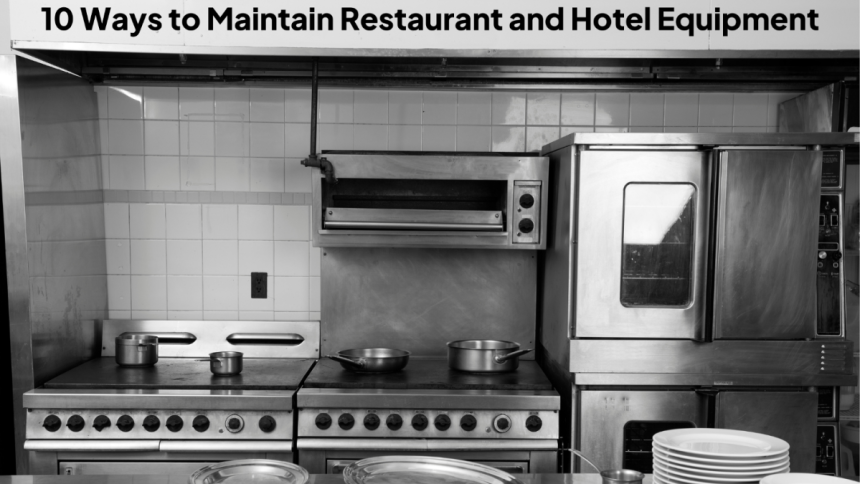For restaurant and hotel owners, maintaining equipment is a constant concern that impacts both daily operations and long-term business success. Equipment breakdowns can lead to costly disruptions, reduced service quality, and unsatisfied guests.
The pressure of maintaining smooth operations while controlling repair and replacement costs can be challenging. But with the right maintenance strategies, it’s possible to avoid unexpected downtime, minimise expenses, and maximise the lifespan of your most critical assets.
Read on to discover 10 essential maintenance practices that will help you optimise performance and keep your equipment in top condition for years to come.
Choosing the Right Quality Equipment for Long-Term Success
For long-term success, hotel and restaurant owners need to invest in quality equipment that withstands daily demands. This choice impacts efficiency, reduces maintenance expenses, and enhances customer satisfaction.
When sourcing kitchen and hotel supplies, it’s important to find suppliers that prioritize durability and reliability. Suppliers like Restofair RAK, known for offering durable, dependable equipment tailored to modern hospitality needs, allow hotel and restaurant owners to focus on operations without worrying about frequent replacements or breakdowns.
With a solid foundation in place, understanding how to maintain your restaurant and hotel equipment becomes the next step. Below are 10 essential maintenance tips to help you maximise the longevity and performance of your investments.
Equipment Maintenance Checklist for Restaurants and Hotels
| Maintenance Task | Frequency | Notes |
| Regular Cleaning and Sanitisation | Daily/Weekly | Follow specific cleaning schedules. |
| Use Proper Cleaning Solutions | Ongoing | Use safe, recommended cleaning agents. |
| Staff Training on Cleaning Procedures | Monthly/Quarterly | Conduct workshops and provide training guides. |
| Scheduled Inspections | Monthly | Document inspections in maintenance logs. |
| Early Fault Detection | Ongoing | Train staff to identify unusual noises and performance dips. |
| Timely Repairs by Certified Technicians | As Needed | Ensure repairs are done by certified technicians. |
| Use of Protective Covers | Ongoing | Protect equipment from dust and spills. |
| Placement of Mats and Stabilisers | Ongoing | Prevent equipment shifting and reduce vibration. |
| Proper Equipment Training | Ongoing | Ensure staff are well-versed in user manuals and protocols. |
| Maintain Optimal Environmental Conditions | Ongoing | Monitor temperature and humidity; ensure proper ventilation. |
| Schedule Professional Maintenance Services | Annually/Biannually | Enter into annual contracts for detailed checks. |
| Implement Energy-Efficient Practices | Ongoing | Enable energy-saving modes and unplug when not in use. |
| Regular Lubrication of Moving Parts | Monthly/As Needed | Prevents wear and ensures smooth operation. |
| Calibration of Equipment | Biannually/As Needed | Keeps performance accurate and efficient. |
| Maintain a Spare Parts Inventory | Ongoing | Stock essential parts and prepare emergency repair kits. |
1. Regular Cleaning and Sanitisation
Maintaining clean and sanitised equipment is a top priority in both restaurants and hotels. Daily and weekly cleaning routines can reduce equipment failure risks.
Establishing Daily and Weekly Cleaning Routines
Creating strict cleaning schedules helps maintain equipment such as ovens, stoves, and refrigerators. Implement daily wipe-downs and more intensive weekly cleaning to keep your equipment functioning at its best.
Proper Cleaning Solutions
Ensure that you’re using safe and effective cleaning solutions tailored to each type of equipment. Using incorrect cleaning agents may lead to premature wear and tear.
Staff Training
Proper training in cleaning procedures is essential. Employees who know how to clean equipment correctly can decrease downtime. Consider implementing training workshops and quick guides for new staff.
2. Scheduled Inspections
Routine inspections catch issues potentially arising before they become major problems. The equipment must, therefore, be regularly inspected at least once a month to ensure it is in an optimal condition for use.
Routine Maintenance Visits
The periodical checks will ensure that even minute signs of wear and tear are detected for correction. Such assessments should be documented, thus permitting proper tracking of maintenance history and the possibility of unanticipated failure.
Inspection Log
Maintaining inspection logs helps ensure health and safety standards are consistently met. Additionally, these records support future audits by providing evidence of regular maintenance, which can reduce liability risks.
3. Timely Repairs and Replacements
Proactive maintenance avoids the drifting of small problems to major ones that may require high-valued repairs or replacements.
Identifying Issues Early
Detecting faults early saves thousands in repair costs. Train the personnel to detect unusual noises, vibrations, or performance dips and report at once.
Certified Technicians
Always hire certified technicians if you want good repairs. Professional experience guarantees that the task is done right, minimising the chances of complications.
4. Use of Protective Gear and Equipment Accessories
Protecting equipment from potential damage is an often overlooked but essential part of maintenance.
Utilising Protective Covers
Protective covers shield equipment from dust, spills, and other contaminants. This simple addition can extend the life of machines and reduce cleaning frequency.
Mats and Stabilisers
Anti-slip mats and stabilisers prevent equipment from shifting and reduce vibrations that could cause wear over time.
5. Proper Training for Equipment Use
Improper use of equipment often leads to malfunction and breakdowns. Proper training helps avoid these issues.
User Manuals and Protocols
Staff should be well-versed in equipment manuals and follow established operating protocols. Clear instructions help prevent misuse and potential damage.
Continuous Education
Organise regular training sessions to update staff on the correct use of equipment and any new technology. This is particularly important in the hospitality sector, where turnover can be high.
6. Maintain Optimal Environmental Conditions
Climate control solutions maintain optimal temperatures, which is crucial for refrigeration units and ovens. Sudden temperature shifts can damage these types of equipment. High humidity is also destructive.
Ventilation and Airflow
Proper ventilation is generally effective for the prevention of overheating and smooth operation of equipment. All equipment should be placed in areas that will allow for adequate airflow, thereby helping to prevent or minimise the strain.
7. Scheduled Professional Maintenance Services
After all, for all that in-house maintenance is of great importance, professional servicing does it in a much superior, intensive check.
Annual Contracts
Entering annual maintenance contracts with more reputable companies can ensure one gets regular, detailed servicing. Such regular checks help identify otherwise unrecognisable problems at an annual check-up.
Request Thorough Service Reports
Demand detailed reports after every professional service. You will be able to track the status of your equipment and predict future maintenance requirements with documentation.
8. Implementing Energy-Efficient Practises
Energy efficiency not only saves operative cost but also protects equipment from unnecessary wear and tear.
Power Management
Next, unplug equipment when not in use and enable energy-saving modes. Such little things prevent overheating as well as extend the life of equipment.
Modern Energy-Efficient Equipment
They should upgrade their old models to new energy-friendly models. The ones they have used earlier consume less energy and sometimes have an inbuilt preservation mechanism for the inner machinery. Therefore, their lifespan will be more enhanced.
9. Lubrication and Calibration
Lubrication and calibration are often overlooked but are critical to maintaining mechanical equipment.
Regular Lubrication
Lubricate moving parts to prevent friction and wear. This simple practise keeps machines running smoothly and prevents mechanical breakdowns.
Precise Calibration
Ensure that your equipment, such as ovens and refrigeration units, is calibrated regularly. Proper calibration ensures that equipment operates accurately, reducing the risk of uneven wear or inefficient use.
10. Maintain a Spare Parts Inventory
Maintaining a spare parts inventory can prevent costly downtime and disruption by ensuring quick repairs during emergencies.
Stocking Necessary Components
Commonly needed parts like belts, filters, and bulbs can be kept in stock. This means that smaller repairs can be undertaken promptly and without the need to wait for parts to arrive.
Emergency Repair Kits
Prepare emergency kits pre-equipped with basic tools and parts to facilitate fast fixes. This will limit downtime and mean daily operations are not interrupted by a possible break.
Key Maintenance Practises and Benefits
| Maintenance Practise | Key Benefit |
| Regular Cleaning and Sanitisation | Reduces equipment failure |
| Scheduled Inspections | Prevents potential breakdowns |
| Timely Repairs | Saves on costly major repairs |
| Use of Protective Gear | Extends lifespan, minimises damage |
| Proper Training | Reduces misuse and malfunction |
| Optimal Environmental Conditions | Prevents overheating and strain |
| Professional Maintenance | Ensures thorough equipment checks |
| Energy-Efficient Practises | Lowers operational costs, extends life |
| Lubrication and Calibration | Maintains smooth operation |
| Spare Parts Inventory | Minimises downtime during repairs |
FAQs
What is the recommended frequency for equipment inspections?
Equipment should be inspected every month to help identify potential issues before they become too expensive to repair.
What type of training should staff receive on equipment maintenance?
Staff should undergo on-the-job training, attend recurrent workshops, and have a clear guideline on Are energy-efficient practices really effective for equipment longevity?
Yes, for example, energy conserving can be applied to prolong equipment life much beyond the typical limit. It minimises operational stress and avoids undue wear and tear on equipment.
Lynn Martelli is an editor at Readability. She received her MFA in Creative Writing from Antioch University and has worked as an editor for over 10 years. Lynn has edited a wide variety of books, including fiction, non-fiction, memoirs, and more. In her free time, Lynn enjoys reading, writing, and spending time with her family and friends.















